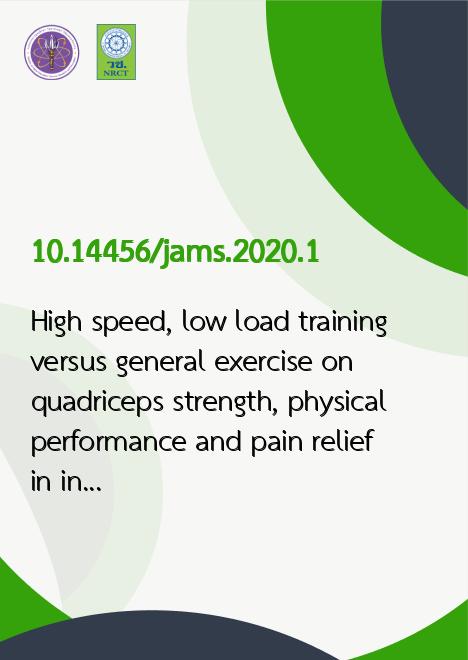
|
High speed, low load training versus general exercise on quadriceps strength, physical performance and pain relief in individuals with knee osteoarthritis |
|---|---|
| รหัสดีโอไอ | |
| Creator | 1. Worrawat Thananchai 2. Aatit Puangmali 3. Suwit Ariyachaikul |
| Title | High speed, low load training versus general exercise on quadriceps strength, physical performance and pain relief in individuals with knee osteoarthritis |
| Publisher | Faculty of Associated Medical Sciences, Chiang Mai University |
| Publication Year | 2563 |
| Journal Title | Journal of Associated Medical Sciences |
| Journal Vol. | 53 |
| Journal No. | 1 |
| Page no. | 1-7 |
| Keyword | Knee osteoarthritis, high speed, low load training, muscle strength, physical performance |
| URL Website | https://www.tci-thaijo.org/index.php/bulletinAMS/index |
| Website title | Journal of Associated Medical Sciences |
| ISSN | 25396056 |
| Abstract | Background: Knee osteoarthritis (OA) is found generally among elderly. High speed, low load (HSLL) training is an alternative resistance exercise for elderly that improves muscle strength and physical function. Therefore, this home-based exercise using elastic bands may improve muscle strength and physical performance efficiently in elderly with knee OA. Objectives: To determine the effects of HSLL training on quadriceps muscle strength, physical performance and pain in individuals with knee OA. Materials and methods: Forty-one participants (6 males and 35 females) with a mean age of 65.05ฑ7.15 years were divided randomly into HSLL group (n=20) and control (CON) group, who practiced general exercise (n=21). Both groups performed exercise 3 days/week for 8 weeks. For the outcome measures, the study considered the maximum voluntary isometric contractions torque (MVICT), 5 sit to stand test (5STST), 4-step stair climb test (4SSCT), 10m walk test (10MWT), knee injury and osteoarthritis outcome score-physical function short form (KOOS-PS), and visual analog scale (VAS) which were carried out before and after the training. Results: MVICT increased significantly in HSLL and CON group after training (p<0.01 and p<0.05 respectively), whereas, the 10MWT, 4SSCT, KOOS-PS and VAS (p<0.01) decreased significantly. Although HSLL group provided a higher percentage of changes than CON group. However, no significant differences between the groups were evident for any measured parameters. Conclusion: HSLL training and general exercise are beneficial for individuals with knee OA regarding the quadriceps muscle strength, physical performance and pain relief. |